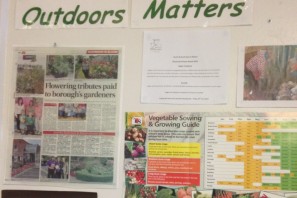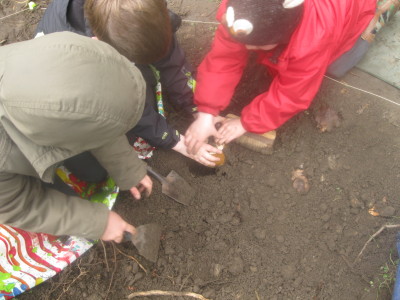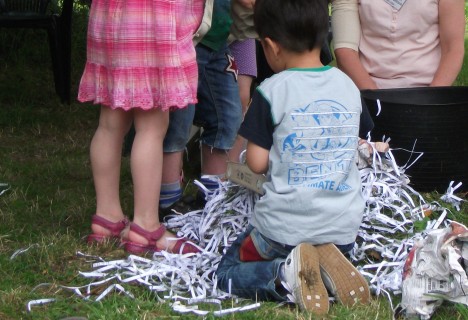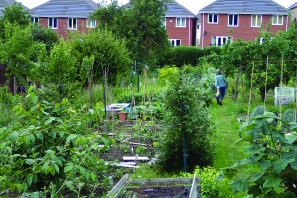Context
Our Nursery school is a 150-place nursery in the centre of a mid-sized town. We serve a very mixed area, parents range from Company directors to single parents living on benefits. Evidence from home visits show that a high percentage of our families live in small flats with no access to gardens or safe places to play. Upwards of 20% of our children have English as an additional language, and we have high numbers of children on free school meals and with additional needs. We are co-located with a special school nursery class and liaise closely with local pre schools, nurseries and schools.
Starting points
About three years ago we were involved in a Community Cohesion project and as a result we accessed some Global Citizenship training. This led us to develop some strong partnerships with four of our local schools and we jointly planned some extra-curricular activities for our more vulnerable children and strengthened our transition process as pupils move from Primary to Secondary school.
It was important to us that all staff including Learning Support Assistants and our shared Special Education Needs staff were all involved and received the same training as teaching staff.
This training led us to realise that the issues surrounding Global Citizenship and educating people in this area was going to be as important for the staff as for the children. It was the starting point for many discussions around our resources, parent/staff and child expectations and attitudes, our environment and our own perceptions of sustainability, diversity and human rights.
There were four areas we began to work on: teaching and learning, staff development, resources, and the school environment.
The main area we decided to focus on was the environment as we were having our outside area redeveloped and this made us confront issues surrounding all the statements in the Re-Activity
| rethink | refuse | reuse | repair | reduce | refill | recharge | recycle |
The Environment
We were redeveloping our outside area and this seemed the perfect opportunity to reassess our plans, challenge our thoughts and think about opportunities for sustainability. We need to promote to our children, through our own actions and the environment we provide, the essential elements of the impact that we make on our environment and on the lives of those around us.
As a starting point we looked at each of the Re statements and thought about what we are already doing and what we could do to improve our impact. A lot of the actions required a rethinking for staff first before we could model them to the children.
| The 8 “R”s | What we were already doing | How we could improve | Outdoor development |
| Rethink | We were already conscious of the amount of paper we use. After consulting the parents they were keen to have letters etc emailed and reminders texted to them. Staff meeting notes and governors meetings minutes are now emailed to staff rather than printed off. Childrens records are stored electronically where appropriate and we do not print these off unless requested to do so. We try to buy wooden furniture from sustainable sources and it lasts for a long time and is easily repairable.
|
We need to ensure we rethink some of the processes in school to ensure the best and most efficient use of resources, the most sustainable way of sourcing and using them and how we get rid of resources when we have finished with them.
We need to do some activities with the children about local foods and the costs of importing foods. |
Rethink the materials we use, the sustainability and access to growing areas, composting etc
The parents wait in our garden and if we labelled up the plants or the compost heap with information around global issues and why we have these things in our garden it would educate the parents too. |
| Refuse | We refused the individual cartons of milk for the children and asked for the larger cartons which we could decant into a jug so that children would only take the amount they wanted. This cut down on waste. | We need to question companies about the necessity of excess packaging. We can refuse plastic milk cartonsand ask for milk bottles. | |
| Reuse | Scrap paper is reused in the office and made into scrap notebooks.
For the first time this year our staff Secret Santa presents had to be an item recycled or bought at a charity shop. |
We can reuse more scrap for junk modelling
|
The condemned climbing frame was given to a farm for their goats. We reused as many materials as we could in the new outdoor area, eg railway sleepers, sheds |
| Repair | We always try to repair equipment rather than replace. | The sheds were repaired. | |
| Reduce | We plant vegetables and make soup and other food from our produce. | We could grow more and increase the variety to include herbs and fruit.
We could look at water saving – giving out free water saving devices for toilets to parents.
|
We increased the accessibility of our flowerbeds with wider gaps between the raised beds for wheelchair access. |
| Refill | We use soap dispensers that we refill to cut down on plastic use. | ||
| Recharge | We use rechargeable batteries. |
|
|
| Recycle | We have recycling bins for paper.
Collect clothes for a charity for recycling to those who need them.
We use old wallpaper rolls to paint on. Member of Swindon scrap scheme. |
We need to be recycling plastic as we use so many plastic milk cartons.
|
We have now got two compost bins in the garden and need to encourage the children to take out the organic waste from the snack table. We planted the garden up using all free plants that were being thrown out by the garden centre as being past their best.
Need to look into getting water butts |
Having developed the staff knowledge on the Re-Activity concepts and introduced various new resources and policies to ensure we are doing as much as possible in each area, I now wanted to measure the children’s knowledge. Do they know how to use these resources, why we use them and what happens to the waste?
I would collect up the waste created by the staff at lunch time in the staff room and during a group time, with a small number of children who had been at the school for at least two terms, we would decide what to could do with each item. We would sort the items in to sets: paper recycling, plastics, compost and general rubbish.
Objectives
- To help the children to understand that people’s behaviour has an impact on the environment
- To equip children with the understanding and belief that that they can make a difference
- To foster a sense of responsibility for the environment and for the sustainable use of resources
- To look at lifecycles, rotting and the uses of compost
Aims
- To ensure the children understand their role in reducing waste going to landfill
- To measure the children’s understanding of turning waste into compost
- To measure the understanding of the process of decay to inform future planning
What happened?
I began the session by talking about what the children had had for their lunch. I particularly concentrated on those who had a packed lunch at school. All the children who stay for lunch have a packed lunch as we don’t have a kitchen on site and therefore waste is a big concern, for example because of with increased use of packaging.
I then showed the children the box in which I had put all the waste from the teachers’ lunches. We discussed where all the waste would go. Initially the only answer that came forth was the bin. We talked about the different sorts of bins we had around Nursery and what we would put in to each bin. The children knew what sorts of things went in each bin but then told me that at the end of the day all the bins would be tipped in to the big bins outside!! I realised there was really very little understanding about sorting waste and the ways in which we could reuse that waste.
We walked around Nursery and looked at each sort of bin and what was in them. We then spent some time looking at the outside compost bin and what had started to happen to the waste inside it. We then returned to the classroom and I simplified the activity by sorting the waste into what we would put in the compost bin and what we couldn’t. I had hoped to sort the rubbish in to all the right categories of bin but realised that concentrating on one sort of waste would be enough. We had two large pieces of paper and the children sorted the objects from the box of the teachers’ lunch box waste.
Evaluation
I shall now feed back to the staff the responses I had from the children. I think we need to break down the activities into smaller chunks and concentrate on one sort of recycling at a time. We need to plan in some activities around decay and what happens to organic matter compared, for example to plastic or glass.
I think we are improving as a school, after all our work on the outside area, introducing recycling, and cutting our use of paper (e.g. newsletters, minutes and notices all go out on email or text now), and promoting walking to school with a buggy park and stickers for walking to school.
To keep progressing, I now want to look at using the environment as a learning tool itself. Whilst all the resources are there, the staff are going to have to support and plan the learning in a more structured form to achieve the understanding I think the children are lacking. As part of our School Development Plan we are looking at challenge and extension activities in the outdoor area and have a member of staff in charge of this development. I shall now talk to her in detail and we can plan how we can ensure that whilst we recycle and promote sustainability we ensure the children have a better understanding of the processes and why we are doing them.




